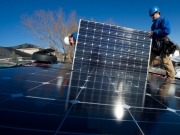
Over the next 10 days, DECC will be deciding on the level of financial support for solar power under the Renewables Obligation (RO). The consultation has focused on utility-scale solar (5MW+), but the Solar Trade Association (STA) has raised concerns with DECC that the needs of mid-sized installations in the non-domestic sector must also be addressed. Nothing has been built in the largest FIT band (250kW-5MW) since the FIT was reduced to just 7.1p in July. The RO at 2 ROCs had just begun to support mid-size solar but it is unclear how this sub-sector will be enabled going forwards.
In its recent response to the Renewable Obligation Banding Review, the STA, backed by industry members, said the extraordinary cost reductions in solar power justified a decrease in the RO for utility solar, but only to a level of 1.8 ROCs for April 2013. In addition it was vital that action was taken to enable the important mid-size roof-mounted sub-sector to take off. The STA is concerned this cost effective application of solar risks falling through the policy framework.
“Solar power can deploy quickly and help the UK address its looming energy crunch and the lack of sector competition” said STA CEO Paul Barwell. “It is an easy and cost-effective win because it is now cheaper than many other low carbon options. Suppressing solar power wouldn’t make any sense from a value-for-money perspective. Solar power is set to offer businesses and households cheaper power than grid electricity before the end of this decade so there are excellent strategic reasons for Government to champion the UK industry. We very much hope that DECC will deliver a framework that supports all sub-sectors of solar power.”
The STA believes there are many reasons why solar PV should be vigorously supported. For a start, there is a lot of public praise for solar, DECC’s own analysis shows 83% support for solar, and 55% would be happy to have a large scale renewable development in their area. Mainstream analyses show future solar costs are likely to be lower in real terms compared to fossil fuel prices and solar is decentralized, producing electricity close to regional demand and delivering potential network savings. Solar is also a ‘heavy lifter’ technology that can make a major contribution to our electricity demand. South facing roofs and facades alone could deliver around 1/3 of UK electricity supply.
Secondly, storage of localised electricity is becoming an economic reality and can be easily retrofitted to systems. The Chancellor recently flagged the potential of storage to save up to £10 billion per annum by 2020 on energy costs.
Finally, utility-scale solar can make use of brownfield land and contaminated sites, as well as multi-task with poor grade agricultural land, for example combined with grazing. Solar power also opens up the electricity sector to potentially millions of new investors, transforming ownership and competition in the UK’s consolidated electricity markets
Further information:
Consultation on proposals for levels of banded support
I just hope whoever writes these keeps writing more!
This is a really intelligent way to answer the question.

